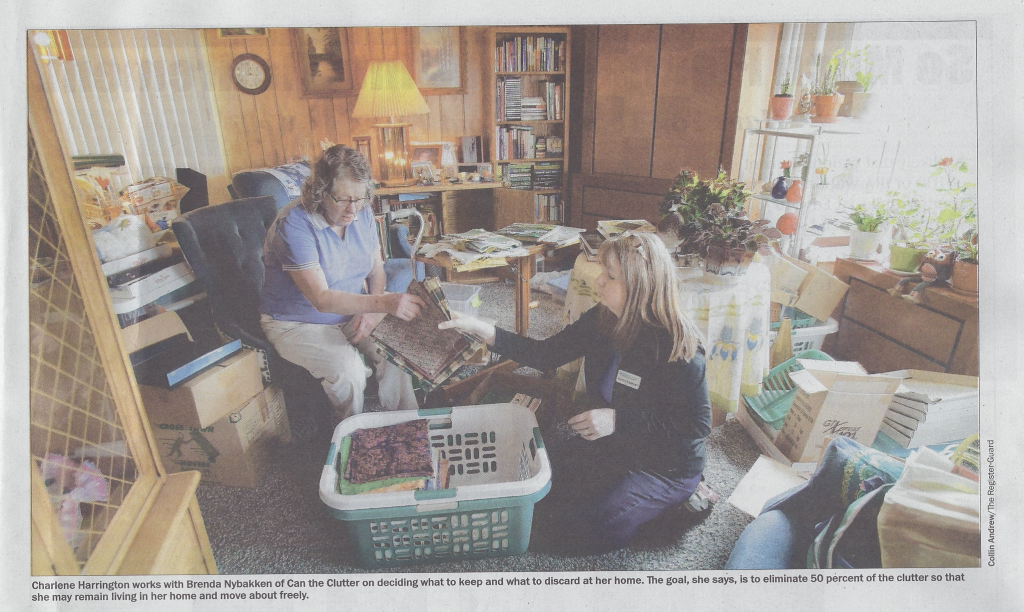This was one of three articles that was published in the March 2014 edition of the Register-Guard’s annual retirement guide. This special publication wasn’t available online, so I apologize for the scraggly scans. This was one story, about downsizing and de-cluttering your home later in life, so that you can either move to a smaller home or remain in your home safely. The other two were about about frauds that senior citizens are vulnerable to, lifelong learning opportunities through community organizations, the University of Oregon and Lane Community College.
Downsizing Your Life
Whether you’re moving or staying put, downsizing doesn’t have to be overwhelming
By Vanessa Salvia
Throughout most of our lives, moves come with a sense of “pregnant anticipation,” explains Diane Masarie, owner of Move-In Comfort. There’s a sense of moving on to something bigger and better—moving to college, moving into your first home, moving into a bigger home when children arrive, moving to a nicer home. But when seniors move, the feeling is not always one of excitement. “Everyone’s anxiety is up,” Masarie says, “even if the move is something that’s wanted.”
Masarie, a senior move manager with Move-In Comfort, has been in business for more than 10 years, helping seniors transition to smaller homes or helping them stay in their home. “We help people focus,” Masarie explains. She helps turn the large task of downsizing into manageable pieces, and asks a lot of questions to help the person discern what’s important to them, to help make the decisions that are right for them. “We eliminate the word ‘should,’” Masarie says. “The goal is that the person has made decisions that they can live with, that they have no regrets about, so that they are surrounded by things they love.”
One false impression of downsizing, says Masarie, is that in order to make space you have to get rid of all the things that are meaningful. “If it’s done in a well-paced and thoughtful manner, we don’t have to get rid of the things that are near and dear.” Masarie says, “Most of us have so much stuff that we’re surrounded by things we don’t even see anymore.”
Most of Masarie’s clients are transitioning to a retirement home, though she has experienced an increase in people wanting to stay in their homes. Sometimes downsizing is a matter of safety, as it was for Charlene Harrington, a client of Jan Lehman, owner of Can The Clutter. Harrington is halfway through her downsizing with Lehman. She’s 74 and has had several strokes. “I’m making it so I can stay in my home and move around freely,” Harrington says.
So far, Harrington’s experience has gone “quite well.” “The goal is to remove 50 percent of the clutter and we’re close to that goal. It’s a hard process for me. Sometimes it’s an emotional thing and sometimes I can’t explain why I can’t get rid of something, but usually it’s just common sense. I don’t think anyone should feel intimidated by hiring an agency of this nature because it really does help to clear things out.”
Masarie points to research showing that how someone integrates the process of moving to what is probably their last home greatly impacts how well they adapt to their new living situation or environment. “If they’re not supported, or rushed through the process–before their insides have a chance to catch up with their outside– and don’t feel that they have a say in what they keep and what they leave behind,” Masarie says, “it can be traumatizing and very upsetting.”
Colleen Brooks recently packed up her home of 35 years and moved from Sweet Home to Vashon Island, Washington, following the death of her husband. “After five children, 15 grandchildren, countless graduations, weddings and birthdays, we had a lot of stuff,” Brooks says. “It was overwhelming.” Even though her and her husband, Bernie, lived a simple life, she was still surprised at the amount of “stuff” they had accumulated.
Brooks didn’t have a downsizing or organizing expert helping her, but her grief counselor gave her some wise advice: “It’s not the things that you want to keep but the memories of the things,” she says. “That’s what I needed help remembering.” Her counselor’s advice was to write down memories of things and events in a journal, to keep for the future. Brooks did have professional moving help, which she said was a relief.
Lehman works with clients to help preserve memories in creative ways. “We tell people it’s not about the physical stuff, it’s about having a trigger to bring out that memory.” A strategy that Lehman recommends is to take photos of items and display them in a digital photo album. “We figure out how to preserve memories and bring functional things into a smaller space,” she says.
In Lehman’s experience, it’s not uncommon to find people struggling to fit their hobby into one corner of the house, though their children have moved out and their rooms are still intact. “When we organize people I would honestly say, 50 percent is changing the physical space and 50 percent is changing someone’s behavior or the way they look at things,” she says. “And it is absolutely emotional.”
It’s also a huge stress relief to have someone help you. “We all go through change and my belief is that we do it best when we aren’t alone and have support and guidance,” says Masarie. “Downsizing can be a very empowering experience for people when they are the one ‘in the driver’s seat’ and responsible for their decisions about what goes and what stays.”

No comments yet.